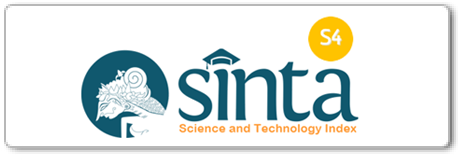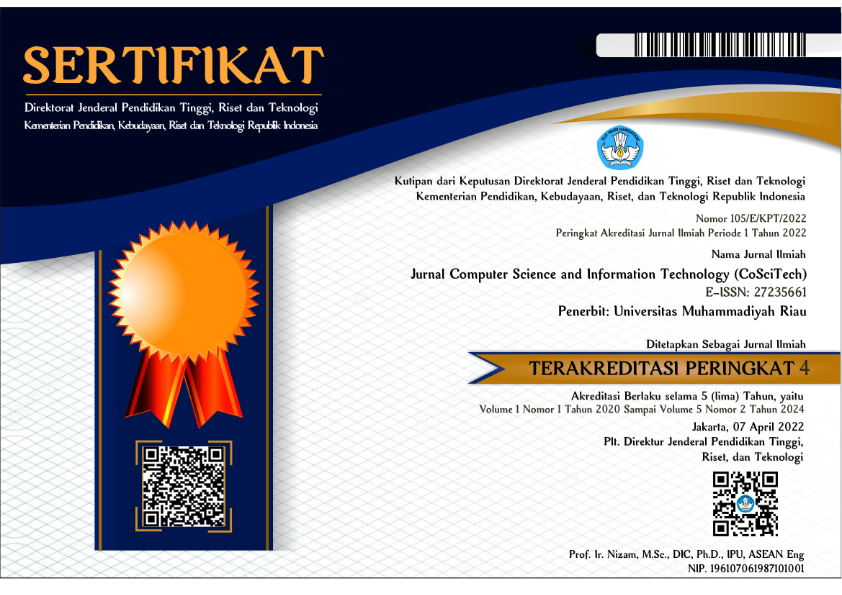Comparison of c4.5 and naive Bayes algorithms in predicting student graduation
DOI:
 https://doi.org/10.37859/coscitech.v4i1.4755
https://doi.org/10.37859/coscitech.v4i1.4755
Abstract
College management requires graduation predictions to determine early prevention measures for drop out cases. The length of a student's study period can be caused by various factors, so it is necessary to know which students have the potential to graduate not on time. Data mining techniques can be used to explore new knowledge so that it can produce predictions of student graduation. Some algorithms that can be used are C4.5 and Naive Bayes. The purpose of this study was to predict the graduation of students from the Faculty of Social and Political Sciences at Andalas University using the C4.5 and Naive Bayes algorithms. The attributes used are age at college, gender, grade point average 1-4. The data used are FISIP undergraduate students who graduated in 2022 as many as 378. The results show that the accuracy of the Naive Bayes algorithm is better than C4.5 with the highest accuracy of 81.58%.
Downloads
References
[2] Ademl Husejinovic, “Credit Card Fraud Detection Using Naive Bayesian and C4.5 Decision Tree Classifiers,” Periodicals of Engineering and Natural Sciences, Jan. 01, 2020. https://papers.ssrn.com/sol3/papers.cfm?abstract_id=3521283 (accessed Mar. 21, 2023).
[3] F. Zhou, L. Xue, Z. Yan, and Y. Wen, “Research on college graduates employment prediction model based on C4.5 algorithm,” J Phys Conf Ser, vol. 1453, p. 12033, 2020, doi: 10.1088/1742-6596/1453/1/012033.
[4] Y. Fitriani, S. Defit, and G. W. Nurcahyo, “Prediksi Hasil Belajar Siswa Secara Daring pada Masa Pandemi COVID-19 Menggunakan Metode C4.5,” Jurnal Sistim Informasi dan Teknologi, pp. 120–127, Aug. 2021, doi: 10.37034/jsisfotek.v3i3.54.
[5] C. N. Dengen, K. Kusrini, and E. T. Luthfi, “Implementasi Decision Tree Untuk Prediksi Kelulusan Mahasiswa Tepat Waktu,” SISFOTENIKA, vol. 10, no. 1, p. 1, Jan. 2020, doi: 10.30700/jst.v10i1.484.
[6] Budiyantara, A., Irwansyah, I., Prengki, E., Pratama, P. A., & Wiliani, N. “Komparasi Algoritma Decision Tree, Naive Bayes Dan K-Nearest Neighbor Untuk Memprediksi Mahasiswa Lulus Tepat Waktu”. JITK (Jurnal Ilmu Pengetahuan Dan Teknologi Komputer), 5(2), 265-270. 2020, doi: https://doi.org/10.33480/jitk.v5i2.1214
[7] Hozairi, H., Anwari, A., & Alim, S. “Implementasi Orange Data Mining Untuk Klasifikasi Kelulusan Mahasiswa Dengan Model K-Nearest Neighbor, Decision Tree Serta Naive Bayes. Network Engineering Research Operation”, 6(2), 133-144. 2021,DOI: http://dx.doi.org/10.21107/nero.v6i2.237.
[8] Sutoyo, E., & Almaarif, A. (2020). Educational data mining untuk prediksi kelulusan mahasiswa menggunakan algoritme Naïve Bayes classifier. J. RESTI (Rekayasa Sist. dan Teknol. Informasi), 4(1), 95-101. DOI: https://doi.org/10.29207/resti.v4i1.1502
[9] Nurul Khasanah, Agus Salim, Nurul Afni, Rachman Komarudin, and Yana Iqbal Maulana, “PREDIKSI KELULUSAN MAHASISWA DENGAN METODE NAIVE BAYES,” 2022. doi: http://dx.doi.org/10.31602/tji.v13i3.7312.
[10] J. Galopo Perez and E. S. Perez, “Modern Education and Computer Science,” Modern Education and Computer Science, vol. 3, pp. 57–67, 2021, doi: 10.5815/ijmecs.2021.03.05.
[11] E. B. Susanto, Paminto Agung Christianto, Mohammad Reza Maulana, and Sattriedi Wahyu Binabar, “Analisis Kinerja Algoritma Naïve Bayes Pada Dataset Sentimen Masyarakat Aplikasi NEWSAKPOLE Samsat Jawa Tengah,” Jurnal CoSciTech (Computer Science and Information Technology), vol. 3, no. 3, pp. 234–241, Dec. 2022, doi: 10.37859/coscitech.v3i3.4343.
[12] A. Armansyah and R. K. Ramli, “Model Prediksi Kelulusan Mahasiswa Tepat Waktu dengan Metode Naïve Bayes,” Edumatic: Jurnal Pendidikan Informatika, vol. 6, no. 1, pp. 1–10, Jun. 2022, doi: 10.29408/edumatic.v6i1.4789.
[13] D. Rosita, dan Syamsuddin Mallala, S. Informasi, S. Widya Cipta Dharma, T. Informatika, and P. Korespondensi, “KOMPARASI DATA MINING NAIVE BAYES DAN NEURAL NETWORK MEMPREDIKSI MASA STUDI MAHASISWA S1,” vol. 7, no. 3, pp. 443–452, 2020, doi: 10.25126/jtiik.202072093.
[14] E. Haryatmi and S. Pramita Hervianti, “Penerapan Algoritma Support Vector Machine Untuk Model Prediksi Kelulusan Mahasiswa Tepat Waktu,” Jurnal RESTI (Rekayasa Sistem dan Teknologi Informasi), vol. 5, no. 2, pp. 386–392, Apr. 2021, doi: 10.29207/resti.v5i2.3007.
[15] D. Guswandi, M. Yanto, M. Hafizh, and L. Mayola, “Analisis Hybrid Decision Support System dalam Penentuan Status Kelulusan Mahasiswa,” Jurnal Resti, 2021. http://jurnal.iaii.or.id/index.php/RESTI/article/view/3587/517 (accessed Mar. 21, 2023).
[16] M. Yudhi Putra and D. Ismiyana Putri, “Pemanfaatan Algoritma Naïve Bayes dan K-Nearest Neighbor Untuk Klasifikasi Jurusan Siswa Kelas XI.” 2022, doi: https://doi.org/10.33365/jtk.v16i2.2002.
[17] S. Mutrofin, M. Mughniy Machfud, D. H. Satyareni, R. Venantius, H. Ginardi, and C. Fatichah, “KOMPARASI KINERJA ALGORITMA C4.5, GRADIENT BOOSTING TREES, RANDOM FORESTS, DAN DEEP LEARNING PADA KASUS EDUCATIONAL DATA MINING” 2020, doi: 10.25126/jtiik.2020732665.
[18] L. I. P. Aji and A. Sunyoto, “An Implementation of C4.5 Classification Algorithm to Analyze student’s Performance,” in 2020 3rd International Conference on Information and Communications Technology, ICOIACT 2020, Nov. 2020, pp. 126–130. doi: 10.1109/ICOIACT50329.2020.9332088.














